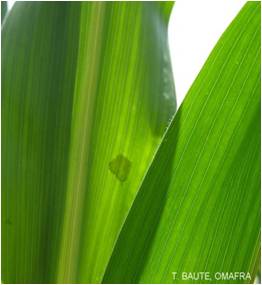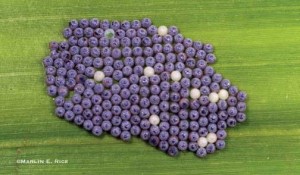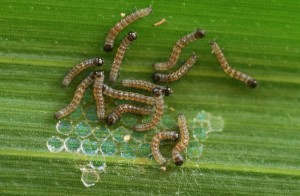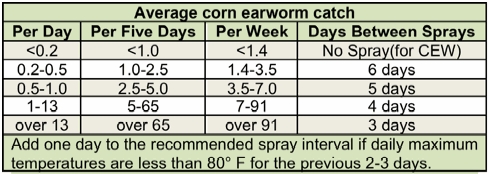Eight sites reported European corn borer (ECB)-E and seven had ECB-Z. ECB-E numbers were very high in a few locations this week. Please refer to the scouting guidelines on this page, Scouting and Threshold Information, for information on how and when to scout for ECB. When scouting, remember that the threshold for tassel emergence corn is 15% but this drops to 5% in silking corn.
Corn earworm (CEW) was found at eight sites, with numbers at three sites in the range indicating a need for a six-day spray interval, please see the chart at the bottom of this page. Two sites reported fall armyworm (FAW).
Western bean cutworm (WBC) was caught at 14 sites this week. WBC emergence is forecast to be at 25% when 1319 degree days (base 50°F) have accumulated beginning on May 1st (see table below). The degree day accumulation (May 1st, base 50°F) for sweet corn trap network sites ranges from 1095-1422 with an average of 1289. Most areas have not yet seen 25% moth emergence. Degree day forecasts pertain only to local populations, the migrant population is much more unpredictable.
| Degree-day accumulations (beginning May 1, base 50°F) and % WBC moth emergence | |
|---|---|
| Accumulated Degree-days |
% Moth Emergence |
|
1319 |
25% |
|
1422 |
50% |
|
1536 |
75% |
WBC will usually lay their eggs on the upper side of the top 1-3 leaves of pre-tassel corn. Eggs are often laid closer to the leaf base. After tasseling has finished WBC seek out younger corn or dry beans. To scout for egg masses check the top 3 leaves of ten corn plants in ten locations throughout the field. The eggs are easy to observe if you view the leaf while holding it towards the sun. The egg mass will appear as a distinct shadow (see photo). The thresholds for sweet corn are still being determined but Michigan State University has recommended using a 4% threshold for processing sweet corn and a 1% threshold for fresh market sweet corn.
It takes between 5-7 days for eggs to hatch. It is critical that sprays are timed before the larvae have a chance to enter the ear. The egg mass will become purple in color approximately 24 hours before egg hatch (see photo).
| Location | ECB-E | ECB-Z | CEW | FAW | WBC |
| Avoca (Steuben Co.) | 0 | 0 | 1 | 0 | 0 |
| Avon (Livingston Co.) | 1 | 1 | 0 | 0 | 2 |
| Baldwinsville (Onondaga Co.) | 0 | 0 | 0 | 0 | 2 |
| Batavia (Genesee Co.) | 43 | 0 | 0 | 0 | 4 |
| Bellona (Yates Co.) | 3 | 1 | 1 | 0 | 7 |
| Eden (Erie Co.) | 0 | 0 | 0 | 0 | 2 |
| Farmington (Ontario Co.) | 55 | 1 | 0 | 0 | 2 |
| Hamlin (Monroe Co.) | 0 | 0 | 2 | 0 | 0 |
| Interlaken (Seneca Co.) | 1 | 0 | 0 | 0 | 1 |
| Kennedy (Chautauqua Co.) | 0 | 0 | 0 | 0 | 5 |
| King Ferry (Cayuga Co.) | 0 | 1 | 2 | 11 | 0 |
| Kirkville (Madison Co.) | 0 | 0 | 0 | 0 | 1 |
| LeRoy (Genesee Co.) | 2 | 5 | 1 | 0 | 0 |
| Lockport (Niagra Co.) | 0 | 0 | 0 | NA | 0 |
| Oswego (Oswego Co.) | NA | NA | NA | NA | NA |
| Owego (Tioga Co.) | NA | NA | NA | NA | NA |
| Penn Yan (Yates Co.) | 1 | 0 | 0 | 1 | 4 |
| Pike (Wyoming Co.) | NA | NA | NA | NA | NA |
| Plessis (Jefferson Co.) | 1 | 0 | 1 | 0 | 4 |
| Preble (Cortland Co.) | 0 | 0 | 0 | 0 | 1 |
| Sherwood (Cayuga Co.) | NA | NA | NA | NA | NA |
| Spencerport (Monroe Co.) | 0 | 0 | 2 | 0 | 0 |
| Waterport (Orleans Co.) | 0 | 0 | 0 | 0 | 1 |
| Williamson (Wayne Co.) | 0 | 1 | 1 | 0 | 8 |
| ECB – European Corn Borer CEW – Corn Earworm FAW – Fall Armyworm WBC – Western Bean Cutworm NA – not available |
|||||
| trap catches for the week of 7.16.13 – 7.23.13 |
|||||




